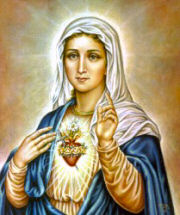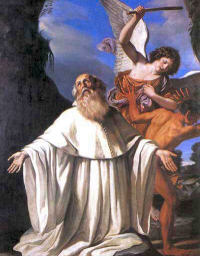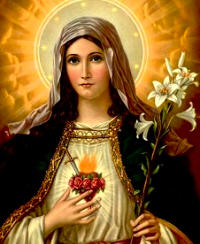Ordinary Time: June 19th
Memorial of the Immaculate Heart of Mary -- (Optional Memorial of St. Romuald, abbot)
» Enjoy our Liturgical Seasons series of e-books!
In the midst of the second world war Pope Pius XII put the whole world under the special protection of our Savior's Mother by consecrating it to her Immaculate Heart, and in 1944 he decreed that in future the whole Church should celebrate the feast of the Immaculate Heart of Mary. This is not a new devotion. In the seventeenth century, St. John Eudes preached it together with that of the Sacred Heart; in the nineteenth century, Pius VII and Pius IX allowed several churches to celebrate a feast of the Pure Heart of Mary. Pius XII instituted today's feast of the Immaculate Heart of Mary for the whole Church, so as to obtain by her intercession "peace among nations, freedom for the Church, the conversion of sinners, the love of purity and the practice of virtue" (Decree of May 4, 1944).
Today is also the feast of St. Romuald, who was born in Ravenna (Italy) of a noble family. Founder of the Camaldolese monks, he was a hermit and a reformer of the monastic customs of his time. He died after a life of prayer and rigorous penance. Before the reform of the Calendar in 1969 his feast was celebrated on February 7, the anniversary of the translation of his relics in 1481. His feast is now June 19, the day he died in 1027. In the Calendar reform the Church has tried to move the feasts of the saints to their "birthday" — referring to the day on which the saint died and celebrated his/her birth into heaven.
Immaculate Heart of Mary
The attention of Christians was early attracted by the love and virtues of the Heart of Mary. The Gospel itself invited this attention with exquisite discretion and delicacy. What was first excited was compassion for the Virgin Mother. It was, so to speak, at the foot of the Cross that the Christian heart first made the acquaintance of the Heart of Mary. Simeon's prophecy paved the way and furnished the devotion with one of its favourite formulae and most popular representations: the heart pierced with a sword. But Mary was not merely passive at the foot of the Cross; "she cooperated through charity", as St. Augustine says, "in the work of our redemption".
It is only in the twelfth, or towards the end of the eleventh century, that slight indications of a regular devotion are perceived in a sermon by St. Bernard (De duodecim stellis).
Stronger evidences are discernible in the pious meditations on the Ave Maria and the Salve Regina, usually attributed either to St. Anselm of Lucca (d. 1080) or St. Bernard; and also in the large book De laudibus B. Mariae Virginis (Douai, 1625) by Richard de Saint-Laurent.
In St. Mechtilde (d. 1298) and St. Gertrude (d. 1302) the devotion had two earnest adherents. A little earlier it had been included by St. Thomas Becket in the devotion to the joys and sorrows of Mary, by Blessed Hermann (d.1245), one of the first spiritual children of St. Dominic, in his other devotions to Mary, and somewhat later it appeared in St. Bridget's Book of Revelations.
 Tauler (d. 1361) beholds in Mary the model of a mystical, just as St. Ambrose perceived in her the model of a virginal soul. St. Bernardine of Siena (d.1444) was more absorbed in the contemplation of the virginal heart, and it is from him that the Church has borrowed the lessons of the Second Nocturn for the feast of the Heart of Mary. St. Francis de Sales speaks of the perfections of this heart, the model of love for God, and dedicated to it his Theotimus.
Tauler (d. 1361) beholds in Mary the model of a mystical, just as St. Ambrose perceived in her the model of a virginal soul. St. Bernardine of Siena (d.1444) was more absorbed in the contemplation of the virginal heart, and it is from him that the Church has borrowed the lessons of the Second Nocturn for the feast of the Heart of Mary. St. Francis de Sales speaks of the perfections of this heart, the model of love for God, and dedicated to it his Theotimus.
In the second half of the sixteenth century and the first half of the seventeenth, ascetic authors dwelt upon this devotion at greater length. It was, however, reserved to St. Jean Eudes (d. 1681) to propagate the devotion, to make it public, and to have a feast celebrated in honor of the Heart of Mary, first at Autun in 1648 and afterwards in a number of French dioceses.
In 1799 Pius VI, then in captivity at Florence, granted the Bishop of Palermo the feast of the Most Pure Heart of Mary for some of the churches in his diocese. In 1805 Pius VII made a new concession, thanks to which the feast was soon widely observed. Such was the existing condition when a twofold movement, started in Paris, gave fresh impetus to the devotion. The two factors of this movement were first of all the revelation of the "miraculous medal" in 1830 and all the prodigies that followed, and then the establishment at Notre-Dame-des-Victoires of the Archconfraternity of the Immaculate Heart of Mary, Refuge of Sinners, which spread rapidly throughout the world and was the source of numberless graces. On 21 July, 1855, the Congregation of Rites finally approved the Office and Mass of the Most Pure Heart of Mary without, however, imposing them upon the Universal Church. — Excerpted from Catholic Encyclopedia, 1913 edition.
St. Romuald, Abbot
 St. Romuald, the founder of the Camaldolese Order, could not decide for a considerable time whether to serve God in a religious life or to remain in the world. After his father killed a relative in a duel at which Romuald was forced to be present, he went to the monastery of St. Apollinaris, near Ravenna, and did penance for forty days. Later, he entered this same monastery as a monk. Then he became a follower of the hermit Marinus in Venice. In the course of time he founded an order of hermits which received its name after the most famous of his foundations, Camalduli in Tuscany.
St. Romuald, the founder of the Camaldolese Order, could not decide for a considerable time whether to serve God in a religious life or to remain in the world. After his father killed a relative in a duel at which Romuald was forced to be present, he went to the monastery of St. Apollinaris, near Ravenna, and did penance for forty days. Later, he entered this same monastery as a monk. Then he became a follower of the hermit Marinus in Venice. In the course of time he founded an order of hermits which received its name after the most famous of his foundations, Camalduli in Tuscany.
Romuald's was one of the strictest orders for men in the West (actually a branch of the Benedictine Order). The members live isolated from one another in small huts, observing strictest silence and perpetual fasting, constantly praying or engaged in manual labor. Our saint enjoyed the special grace of bringing sinners, particularly those of rank and power, back to God. When he died, he was a little over seventy years; he had never used a bed, had always sought out ways of practicing severest penances. Fifteen years later his pupil, the holy doctor of the Church, St. Peter Damian, wrote his biography.
"His greatness lies in the rigorous and austere character of his interpretation of monastic life-an approach that was quite singular and unique. In the deepest recesses of his being, Romuald was an ascetic, a monk; not perhaps, a monk of that serene peace and self-possession exemplified by St. Benedict in his life and described by him in his Rule. Nor was Romuald an organizer who through prudent legislation enabled his spirit to flourish and affect great numbers. He reminds us of the stolid figures inhabiting the Eastern deserts, men who by most rigorous mortification and severest self-inflicted penances gave a wanton world a living example of recollection and contemplation. Their very lives constituted the most powerful sermon. It is in company with men like these that St. Romuald continues to live."
Romuald was not at all a fluent reader. Whenever he made another of his many mistakes, Marinus, his teacher, beat him on his left cheek. Finally it became too much for Romuald. "But, dear master," he said modestly, "hit me on the right cheek in the future. My left ear is almost deaf." The master was surprised at such patience and thereafter acted more considerately.
The saint loved to say, "Better to pray one psalm with devotion and compunction than a hundred with distraction."
When the holy man felt his end was near, he retired to the monastery at Val di Castro. After so many journeys he was eager to begin his final pilgrimage to an eternal resting place. Before the reform of the Calendar in 1969 his feast was celebrated on February 7, the anniversary of the translation of his relics in 1481. His feast is now June 19, the day he died in 1027. In the Calendar reform the Church has tried to move the feasts of the saints to their "birthday" — referring to the day on which the saint died and celebrated his/her birth into heaven.
Symbols: Crutch; ladder.
Often Portrayed as: Monk pointing at a ladder on which other monks are ascending to heaven indicative his founding of his Order.
The Immaculate Heart of Mary
The attention of Christians was early attracted by the love and virtues of the Heart of Mary. The Gospel itself invited this attention with exquisite discretion and delicacy. What was first excited was compassion for the Virgin Mother. It was, so to speak, at the foot of the Cross that the Christian heart first made the acquaintance of the Heart of Mary. Simeon's prophecy paved the way and furnished the devotion with one of its favourite formulae and most popular representations: the heart pierced with a sword. But Mary was not merely passive at the foot of the Cross; "she cooperated through charity," as St. Augustine says, "in the work of our redemption."
It is only in the twelfth, or towards the end of the eleventh century, that slight indications of a regular devotion are perceived in a sermon by St. Bernard (De duodecim stellis).
Stronger evidences are discernible in the pious meditations on the Ave Maria and the Salve Regina, usually attributed either to St. Anselm of Lucca (d. 1080) or St. Bernard; and also in the large book De laudibus B. Mariae Virginis (Douai, 1625) by Richard de Saint-Laurent.
In St. Mechtilde (d. 1298) and St. Gertrude (d. 1302) the devotion had two earnest adherents. A little earlier it had been included by St. Thomas Becket in the devotion to the joys and sorrows of Mary, by Blessed Hermann (d.1245), one of the first spiritual children of St. Dominic, in his other devotions to Mary, and somewhat later it appeared in St. Bridget's Book of Revelations.
 St. Ambrose perceived in her the model of a virginal soul. St. Bernardine of Siena (d.1444) was more absorbed in the contemplation of the virginal heart, and it is from him that the Church has borrowed the lessons of the Second Nocturn for the feast of the Heart of Mary. St. Francis de Sales speaks of the perfections of this heart, the model of love for God, and dedicated to it his Theotimus.
St. Ambrose perceived in her the model of a virginal soul. St. Bernardine of Siena (d.1444) was more absorbed in the contemplation of the virginal heart, and it is from him that the Church has borrowed the lessons of the Second Nocturn for the feast of the Heart of Mary. St. Francis de Sales speaks of the perfections of this heart, the model of love for God, and dedicated to it his Theotimus.
In the second half of the sixteenth century and the first half of the seventeenth, ascetic authors dwelt upon this devotion at greater length. It was, however, reserved to St. Jean Eudes (d. 1681) to propagate the devotion, to make it public, and to have a feast celebrated in honor of the Heart of Mary, first at Autun in 1648 and afterwards in a number of French dioceses.
In 1799 Pius VI, then in captivity at Florence, granted the Bishop of Palermo the feast of the Most Pure Heart of Mary for some of the churches in his diocese. In 1805 Pius VII made a new concession, thanks to which the feast was soon widely observed. Such was the existing condition when a twofold movement, started in Paris, gave fresh impetus to the devotion. The two factors of this movement were first of all the revelation of the "miraculous medal" in 1830 and all the prodigies that followed, and then the establishment at Notre-Dame-des-Victoires of the Archconfraternity of the Immaculate Heart of Mary, Refuge of Sinners, which spread rapidly throughout the world and was the source of numberless graces. On 21 July 1855, the Congregation of Rites finally approved the Office and Mass of the Most Pure Heart of Mary without, however, imposing them upon the Universal Church.
—Excerpted from Catholic Encyclopedia, 1913 edition
Patronage: Angola; Ecuador; Philippines; Congregation of the Holy Ghost; Congregation of the Holy Ghost and of the Immaculate Heart of Mary; Franciscan Missionaries of the Immaculate Heart of Mary; Society of the Sacred Hearts of Jesus and Mary; Missionary Society of the Heart of Mary; Congregation of Missionaries, Sons of the Immaculate Heart of the Blessed Virgin Mary (Claretians); Castelnuovo, Italy; Cava d’Aliga, Italy; Lido Bruca, Italy
Highlights and Things to Do:
- Read more about the Immaculate Heart of Mary:
- Read this article about Saturdays and the Immaculate Heart of Mary.
- See Catholic Cuisine for food ideas.






